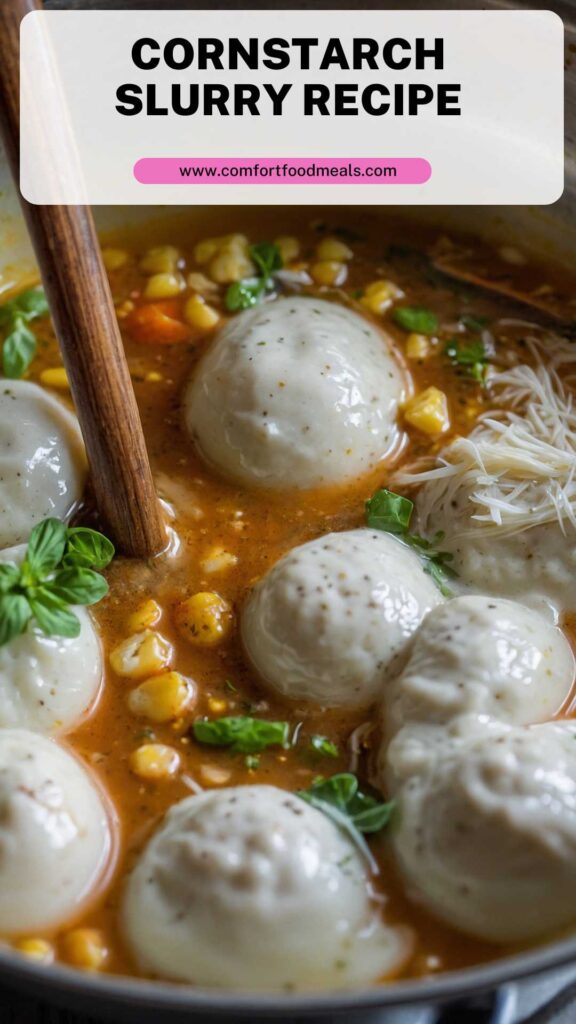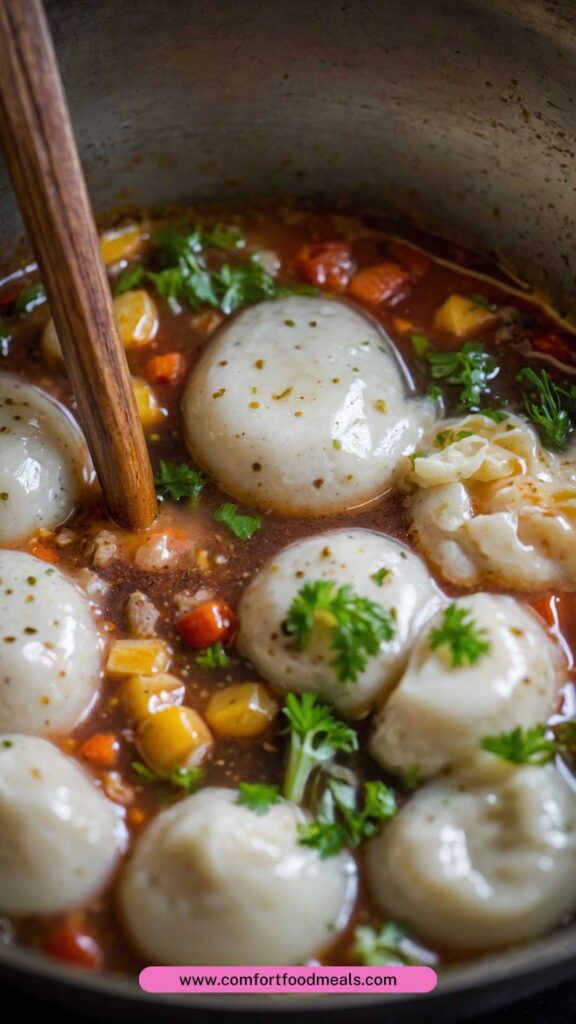Ah, cornstarch slurry—the unsung hero of the kitchen. I remember the first time I used it. I was trying to thicken a luscious homemade gravy for a Sunday roast. The flavor was spot on, but the texture?
It left a lot to be desired. The moment I added that silky, smooth cornstarch slurry, everything changed. If you’ve been there, you know exactly what I’m talking about.
What Dish Pairs Well with Cornstarch Slurry?
Picture this. A hearty chicken stir-fry packed with vibrant vegetables and just a hint of ginger. Or perhaps you envision a velvety broccoli cheese soup, warming your soul on a chilly evening. These dishes deserve a difference-maker.
That’s where the cornstarch slurry comes into play. It transforms runny sauces into rich, inviting gravies. Whatever your culinary creation might be, knowing how to master a cornstarch slurry could elevate your cooking game.

So, what exactly is cornstarch slurry? At its core, it’s a mixture that combines cornstarch with a small amount of liquid, usually water. The key ingredient works like magic to thicken sauces, soups, and gravies with ease.
Not only does it add body to your dishes, but it também retains that glossy finish we all love. You might think you’ve never used it, but if you’ve ever enjoyed a friendly bowl of Chinese takeout, you’ve likely appreciated its effect, even if you didn’t realize it!You Might Also Like These Recipes!
The Ingredients
2 Tbsp of water
1 Tbsp of potato flour or cornstarch
1/2 tsp of garlic powder
1/2 tsp of dried herbs
How to Make Cornstarch Slurry
Creating cornstarch slurry is as simple as pie. It’s quick, requires little skill, and yields delicious flavors. Let’s dive into the step-by-step process.
Step 1: Gather Your Ingredients
This is a straightforward step, but don’t overlook it! Make sure you have your cornstarch and water ready. If you decide to use garlic powder or herbs, have those on standby, too. Trust me, having everything within reach makes cooking so much smoother.
Step 2: Combine the Cornstarch and Water
In a mixing bowl or a small cup, pour in the cornstarch first. Then, add the cold water. This combination allows for better mixing without clumps forming. If you’re feeling fancy, you can sprinkle in some garlic powder or dried herbs at this stage for added flavor.
Step 3: Whisk It Good
Using a fork or a small whisk, mix the cornstarch and water together until you have a smooth, lump-free mixture. A minute of gentle whisking can make all the difference. Keep going until you see a nice, consistent texture.
Step 4: Incorporate into Your Dish
Once your sauce or soup is heated, it’s time to work that magic. Slowly pour the slurry into your bubbling creation. Stir continuously. This ensures even distribution, and you’ll start to see it thicken almost immediately.
Step 5: Cook and Observe
Allow the dish to simmer for a couple of minutes after adding the slurry. This ensures that the cornstarch cooks through and eliminates any starchy taste. Keep an eye on your dish. If it reaches your desired thickness, you’re ready to plate!

Notes: Tips for Success
- Mix Cold: Always use cold water to prevent clumping. Warm water can activate the cornstarch prematurely.
- Stir Well: A thorough whisk is key. No lumps should remain before adding it to your sauce.
- Use a Ratio: The basic ratio is 1 tablespoon of cornstarch to 2 tablespoons of water for a light thickness. Adjust as needed.
- Cook Longer If Needed: If the sauce isn’t thickening to your liking, add a little more slurry and cook for another minute or two.
- Don’t Boil Afterwards: Avoid boiling your sauce after adding the slurry. This can break down the cornstarch and cause everything to thin out again!
Storage Tips
Using cornstarch slurry is best immediately. Yet, if you have leftovers, you can store it in a sealed container in the fridge. Just keep in mind that it may separate. Give it a gentle shake before using it again.
Nutrition Information
Cornstarch Slurry Recipe Nutrition Facts

Serving Suggestions
- Grilled Chicken Stir-Fry
Toss together your favorite vegetables, such as bell peppers and broccoli, with grilled chicken. Drizzle in your cornstarch slurry for a rich, savory glaze. - Hearty Vegetable Soup
Integrate it into a vegetable soup to thicken the broth and give it a more satisfying texture. - Sweet and Sour Chicken
Pair your slurry with sweet and sour sauce to coat chicken pieces. The balance of flavors will impress everyone around the table. - Homemade Fried Rice
Add it to your fried rice to create a creamy consistency. It takes your dish from ordinary to fantastic in one go. - Savory Taco Filling
Use the slurry in taco fillings. It can help bind your meat and veggies together, preventing them from sliding out of the tortilla.
What Are Other Substitutes for Cornstarch Slurry?
There are several alternatives you can use in place of cornstarch slurry. Let’s look at five great substitutes:
- Arrowroot Powder: This flour is an excellent gluten-free thickener. It creates a glossy finish similar to cornstarch. Replace cornstarch with a 1:1 ratio when using it.
- Potato Flour: For those who love root veggies, potato flour works wonders. It’s a bit thicker than cornstarch, so you may need to adjust the quantity.
- Tapioca Starch: Another gluten-free option, tapioca starch, gives a great texture and shine. Use it in a similar ratio as cornstarch.
- Masa Harina: Great for Mexican dishes, masa harina can also thicken sauces. Just keep in mind that it may add a slight corn flavor.
- All-Purpose Flour: If gluten isn’t a concern for you, regular flour works as well. However, you’ll need a bit more—typically, around 2 tablespoons for every tablespoon of cornstarch.
Conclusion
The cornstarch slurry is a simple yet invaluable technique that every home cook should master. Whether you’re thickening a sauce for your favorite stir-fry or adding texture to a satisfying soup, this little mixture can significantly enhance your dishes.
With a few ingredients and some quick steps, it’s a game-changer. So, what are you waiting for? Dig out your cornstarch, and start experimenting with your cooking creations today. You won’t be disappointed!
You Might Also Like These Latest Recipes!
- White Hot Chocolate Recipe
- How To Brown Ground Beef Recipe
- Cheese Puff Bread Fogo De Chao Bread Recipe

Cornstarch Slurry Recipe – Comfort Food Meals
Description
So, what exactly is cornstarch slurry? At its core, it’s a mixture that combines cornstarch with a small amount of liquid, usually water. The key ingredient works like magic to thicken sauces, soups, and gravies with ease.
Ingredients
Instructions
-
Creating cornstarch slurry is as simple as pie. It’s quick, requires little skill, and yields delicious flavors. Let's dive into the step-by-step process.
Step 1: Gather Your Ingredients
-
This is a straightforward step, but don’t overlook it! Make sure you have your cornstarch and water ready. If you decide to use garlic powder or herbs, have those on standby, too. Trust me, having everything within reach makes cooking so much smoother.
Step 2: Combine the Cornstarch and Water
-
In a mixing bowl or a small cup, pour in the cornstarch first. Then, add the cold water. This combination allows for better mixing without clumps forming. If you’re feeling fancy, you can sprinkle in some garlic powder or dried herbs at this stage for added flavor.
Step 3: Whisk It Good
-
Using a fork or a small whisk, mix the cornstarch and water together until you have a smooth, lump-free mixture. A minute of gentle whisking can make all the difference. Keep going until you see a nice, consistent texture.
Step 4: Incorporate into Your Dish
-
Once your sauce or soup is heated, it’s time to work that magic. Slowly pour the slurry into your bubbling creation. Stir continuously. This ensures even distribution, and you’ll start to see it thicken almost immediately.
Step 5: Cook and Observe
-
Allow the dish to simmer for a couple of minutes after adding the slurry. This ensures that the cornstarch cooks through and eliminates any starchy taste. Keep an eye on your dish. If it reaches your desired thickness, you're ready to plate!
Nutrition Facts
Servings 2
- Amount Per Serving
- Calories 62kcal
- % Daily Value *
- Total Fat 3.1g5%
- Saturated Fat 1.2g6%
- Cholesterol 12mg4%
- Sodium 59mg3%
- Total Carbohydrate 5g2%
- Protein 4g8%
* Percent Daily Values are based on a 2,000 calorie diet. Your daily value may be higher or lower depending on your calorie needs.
Note
- Mix Cold: Always use cold water to prevent clumping. Warm water can activate the cornstarch prematurely.
- Stir Well: A thorough whisk is key. No lumps should remain before adding it to your sauce.
- Use a Ratio: The basic ratio is 1 tablespoon of cornstarch to 2 tablespoons of water for a light thickness. Adjust as needed.
- Cook Longer If Needed: If the sauce isn't thickening to your liking, add a little more slurry and cook for another minute or two.
Don’t Boil Afterwards: Avoid boiling your sauce after adding the slurry. This can break down the cornstarch and cause everything to thin out again!


